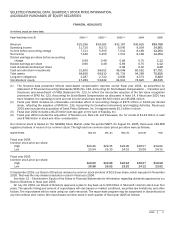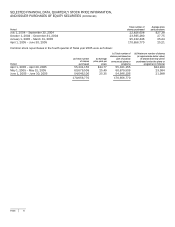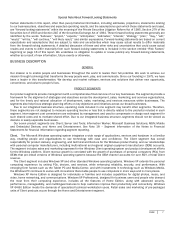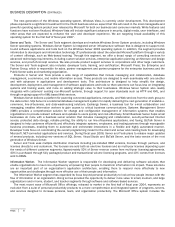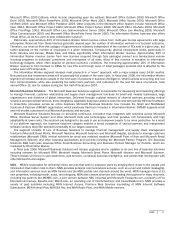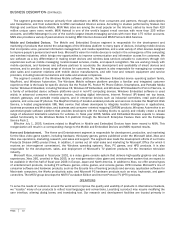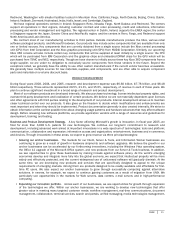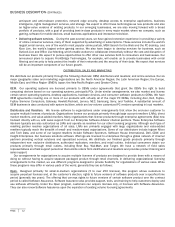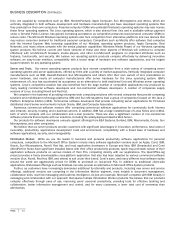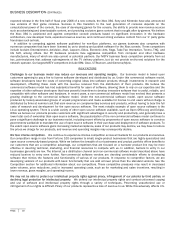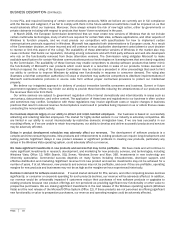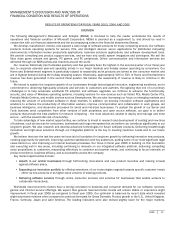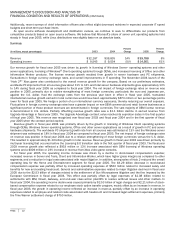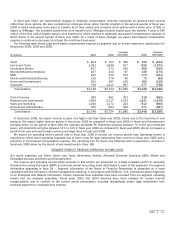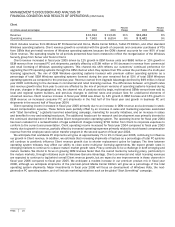Microsoft 2005 Annual Report Download - page 16
Download and view the complete annual report
Please find page 16 of the 2005 Microsoft annual report below. You can navigate through the pages in the report by either clicking on the pages listed below, or by using the keyword search tool below to find specific information within the annual report.
PAGE 15
Microsoft Business Solutions. The products of Microsoft Business Solutions are targeted at small and midsized businesses
(SMB) and larger organizations and divisions of global enterprises. The SMB segment for business solutions is highly
fragmented with many companies in this business. Well-known vendors focused on providing solutions for small and midsized
businesses, such as Intuit and Sage, compete against us for a portion of this segment. The segment consisting of large
organizations and divisions of global enterprises continues to be intensely competitive with a small number of primary vendors
providing products and services such as SAP, Oracle/Peoplesoft and Siebel. In addition these large enterprise-focused vendors
are repositioning some of their business applications to focus on the SMB segment, and divisions of global enterprises, and
thus also compete against us for a portion of the market opportunity. Our business solution products also compete with hosted
solutions offered by companies such as Salesforce.com. In addition, there are thousands of other vendors in specific localities
or industries that offer their own solutions. We believe that our business solutions across financial management, supply chain
management, and customer relationship management (CRM) compete effectively in our target segments by offering integrated
solutions that address multiple segment needs across industries and vertical markets through consistent innovation that are
delivered through a growing network of partners and Independent Software Vendors (ISVs).
MSN. MSN competes with Yahoo!, Google, AOL, and a vast array of Web sites and portals that offer content and online
services of all types to end users, and we compete with these organizations to provide advertising opportunities for merchants
to reach their audiences. MSN also competes for narrowband internet access users with Earthlink, AOL and other ISPs for dial-
up internet access in the United States. The global online advertising market has grown significantly over the past several years,
and we anticipate this trend to continue especially in display and in search-based advertising. As a result competitors are
aggressively developing internet services that provide enhanced functionality for end users in communication services,
improvements in information services such as internet search, and advertising infrastructure and support services including
more effective ways of connecting advertisers with audiences. We have built our own algorithmic search engine to provide end
users with more relevant search results, broader selection of content, and expanded set of search services, and we are
investing to support the continued growth of our advertising business. We are also investing in our communication services, and
our technology, operations, and sales efforts to support the continued growth of our advertising business. We will continue to
introduce new products and services aimed at attracting additional users by improving the user experience in an effort to
increase our satisfaction levels with our end users and merchant customers. Due to the continuing trend of consumers
migrating from narrowband to broadband Internet access, we expect our narrowband Internet access subscriber base to
continue to decline. We believe that we can compete effectively across the breadth of our internet services by providing users
with software innovation in the form of information and communication services that help them find, discover, and experience
what they want online and by providing merchants with effective advertising results through improved systems and sales
support.
Mobile and Embedded Devices. Windows Mobile software faces substantial competition from Nokia, Openwave Systems,
PalmSource, QUALCOMM, and Symbian. The embedded operating system segment is highly fragmented with many competitive
offerings. Key competitors include IBM, Wind River, and versions of embeddable Linux from commercial Linux vendors such as
Metrowerks and MontaVista Software. MapPoint competitors include DeLorme, MapInfo, Mapquest.com, Rand McNally,
Webraska Mobile Technologies, Google, and Yahoo!. The telematics market is also highly fragmented, with competitive offerings
from IBM and automotive suppliers building on various real-time operating system platforms from commercial Linux vendors,
QNX Software Systems, Wind River, and others. We believe that our products compete effectively by providing a familiar
development framework that enables developers to easily write and deploy innovative applications for mobile or embedded
devices; providing a flexible platform that allows customers and partners to build differentiated and profitable business models;
and providing end users significant benefits such as ease of use, personal productivity, and better information management
and control.
Home and Entertainment. The home and entertainment business is highly competitive and is characterized by limited platform
life cycles, frequent introductions of new products and titles, and the development of new technologies. The markets for our
products are characterized by significant price competition. We anticipate continued pricing pressure from our competitors.
From time to time, we have responded to this pressure by reducing prices on certain products. Our competitors vary in size from
very small companies with limited resources to very large, diversified corporations with substantial financial and marketing
resources. We compete primarily on the basis of price, product quality and variety, timing of product releases, and effectiveness
of distribution and marketing.
Our Xbox hardware business competes with console platforms from Nintendo and Sony, both of which have a large
established base of customers. The video game consoles have on average 5 to 7 year lifecycles. We have announced the


